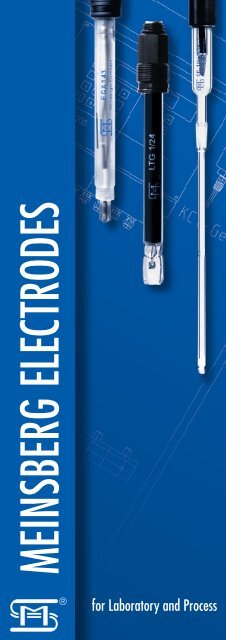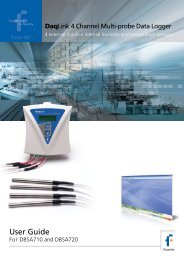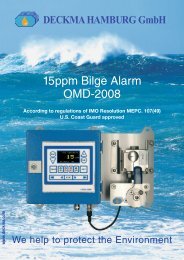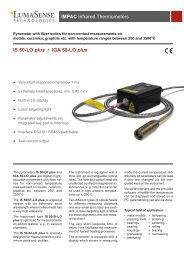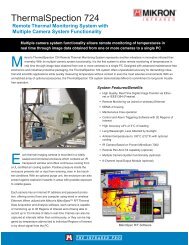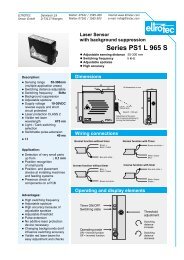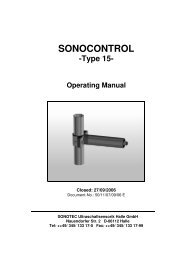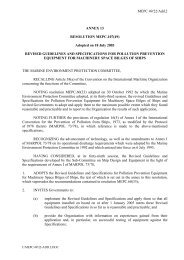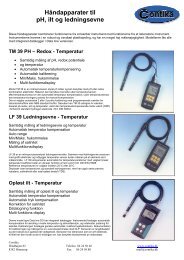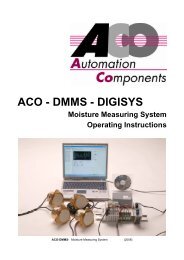Meinsberg Electrodes - Contika
Meinsberg Electrodes - Contika
Meinsberg Electrodes - Contika
You also want an ePaper? Increase the reach of your titles
YUMPU automatically turns print PDFs into web optimized ePapers that Google loves.
MEINSBERG ELECTRODES<br />
for Laboratory and Process
CONTENT<br />
Introduction 1<br />
Laboratory <strong>Electrodes</strong><br />
Application Recommendations 5<br />
Reference <strong>Electrodes</strong> 6<br />
pH Glass Electrode 7<br />
pH Combination <strong>Electrodes</strong> 7<br />
Redox (ORP) Combination <strong>Electrodes</strong> 11<br />
Conductivity Cells 12<br />
Temperature Sensors 12<br />
Corrosion Measuring Cell 13<br />
Connection Cables 13<br />
Process <strong>Electrodes</strong><br />
Application Recommendations 15<br />
Reference <strong>Electrodes</strong> 16<br />
pH Glass Electrode 16<br />
pH Combination <strong>Electrodes</strong> 17<br />
pH/Redox (ORP) Combination <strong>Electrodes</strong> 19<br />
Redox (ORP) Combination <strong>Electrodes</strong> 20<br />
Conductivity Cells 21<br />
Oxygen Sensors 22<br />
Temperature Sensors 23<br />
Connection Cables 23<br />
Technical Instructions<br />
Instructions for using<br />
pH and redox electrodes 24<br />
Cable and Connector codes 25<br />
Standard and Buffer Solutions 26<br />
Customised <strong>Electrodes</strong><br />
and OEM Components 27
MEINSBERG ELECTRODES<br />
FOR LABORATORY AND PROCESS<br />
We develop and manufacture electrodes and sensors for measurement<br />
of pH value, redox potential (ORP), conductivity,<br />
oxygen, carbon dioxide, temperature, chlorine<br />
and other water disinfects.<br />
Laboratory <strong>Electrodes</strong> fulfil all requirements for precise<br />
and accurate measurements<br />
in laboratory and field in<br />
connection with laboratory,<br />
pocket and field meters.<br />
Beyond that we offer a complete<br />
range of electrodes for<br />
the corrosion measurement<br />
technique.<br />
Process <strong>Electrodes</strong> are unique specialists specifically<br />
designed to withstand the most extreme physical and chemical<br />
conditions in process applications for water technology, process<br />
chemistry, biotechnology, and food and pharma industry.<br />
These electrodes, tailored to specific applications, combine high<br />
quality, long life and stability with competitive price.<br />
This catalogue presents our standard range of laboratory and<br />
process electrodes and sensors. Two reviews give a brief overview<br />
of the most usual applications and our recommendations in<br />
combination with measuring hints for selection of the “right”<br />
electrode or sensor to your specific application. We will gladly<br />
provide you with advice regarding other applications or deviating<br />
conditions.<br />
...1
MEINSBERG´s KNOW-HOW:<br />
COMBINATION ELECTRODES<br />
The potentiometric pH and redox measurement is a measurement<br />
of the voltage between two single electrodes (half cells).<br />
The measurement electrode changes its potential in dependence<br />
on pH value or redox potential of the measured medium.<br />
The reference electrode generates a stable voltage against,<br />
nearly independent from the measured medium. In case of<br />
pH measurement the measurement electrode contains a special<br />
pH sensitive glass membrane. Usually a platinum electrode is<br />
used as measurement electrode in redox potential (ORP)<br />
measurements. The reference electrode is either filled with liquid<br />
(refillable) or gel (non-refillable) electrolyte. Stable reference<br />
systems with a special separated silver chloride reservoir are the<br />
basis for reliable long life pH and redox combination electrodes.<br />
The innovative gel or polymer electrolyte features low-maintenance,<br />
easy application and process integration. The diaphragm<br />
of the reference electrode secures the connection to the sample.<br />
High performance ceramic diaphragms, special large-sized ringshaped<br />
sleeves or holes feature reliable liquid junctions.<br />
The combination electrode contains a measurement<br />
and a reference electrode in a common unit.<br />
The pH value of the measured medium as well as the electrode<br />
signal change according to its temperature. Only the simultaneous<br />
measurement of pH and sample temperature features<br />
automatic temperature compensation of the electrode signal and<br />
the comparison of measurement results.<br />
<strong>Meinsberg</strong> pH Combination <strong>Electrodes</strong> with integrated<br />
temperature sensor result in substantially more<br />
precise pH measurements due to automatic temperature<br />
compensation and deliver more information<br />
because of the simultaneous measurement of pH<br />
and temperature.<br />
...2
RELIABILITY<br />
BY QUALITY AND<br />
SPECIAL ELECTRODES<br />
Long-term stable and reliable electrodes and sensors are<br />
the result of a lot of experiences, continuous development and<br />
high manufacturing quality. Each electrode has to fulfil the<br />
strong quality specifications of the final test before dispatch.<br />
Optimised pH sensitive glasses and diaphragms, specifically<br />
developed nearly maintenance free electrolytes, the specific<br />
construction and design as well as storage, operation, maintenance<br />
and process integration influence the live time of the<br />
electrodes / sensors and the reliability of the measurement.<br />
We design and manufacture electrodes and sensors<br />
as reliable tools in accordance with the specific<br />
applications.<br />
Regularly and correct calibration, adjustment and maintenance<br />
are important points for reliable measurements. The calibration<br />
delivers information about the actual specifications of the<br />
electrode/sensor and results in an adaptation of the measuring<br />
instrument to the specific parameters of the electrode.<br />
pH buffer solutions are used for determination of the actual<br />
parameters “isopotential point” and “electrode slope” of the<br />
pH electrode. The slope is the voltage of the pH electrode per<br />
pH unit. Today usual pH combination electrodes give an offset<br />
voltage of about 0 mV at pH 7 (isopotential point).<br />
The accuracy of the measurement results depends<br />
on the regularly calibration and maintenance, the<br />
specific application and measuring conditions as<br />
well as the ageing of the electrode. Please ask for<br />
more information to select the optimal electrode<br />
for your application!<br />
...3
LABORATORY ELECTRODES<br />
Application pH redox<br />
recommendations<br />
(ORP)<br />
general aqueous GA 151/SE 21 EMC 30<br />
solutions, EGA 151<br />
dilute solutions EGA 173<br />
EGA 141<br />
food, EGA 151 EMC 30<br />
drinks EGA 141<br />
penetration measurements EGA 181<br />
in meat, cheese etc. EGA 184<br />
APPLICATION RECOMMENDATIONS<br />
cooling water, EGA 151 EMC 30<br />
raw water, EGA 131 EMC 130<br />
wastewater EGA 173<br />
low ionic strength samples, EGA 161 EMC 30<br />
suspensions, GA 151/SE 20<br />
cosmetics,<br />
water-soluble lacquers<br />
field use, EGA 131 EMC 130<br />
aquarium water, EGA 133 EMC 133<br />
surface water, EGA 141 EMC 134<br />
swimming pools EGA 142<br />
small volumes EGA 501<br />
EGA 801<br />
rapidly changing EGA 141<br />
temperatures, temperature EGA 142<br />
compensated measurements EGA 143<br />
...5
SE 20<br />
SE 21<br />
Reference <strong>Electrodes</strong><br />
Reference electrodes with internal Ag/AgCl<br />
reference system are used in connection<br />
with single pH, redox or ion-selective measurement<br />
electrodes. Reference electrodes<br />
with electrolyte bridge are recommended<br />
especially for ion-selective measurements<br />
because of the possibility to use sample<br />
compatible bridge electrolytes.<br />
-5 ... 80 deg C<br />
glass shaft Ø 12 mm<br />
refillable electrolyte sat. KCl<br />
SE 20:<br />
detachable sleeve junction,<br />
shaft length 120 mm<br />
SE 20/EB:<br />
electrolyte bridge, ceramic diaphragm(inside),<br />
shaft length 160 mm<br />
SE 21:<br />
ceramic diaphragm, shaft length 120 mm<br />
SE 21/EB:<br />
electrolyte bridge, ceramic diaphragm (inside<br />
and outside), stem length 160 mm<br />
SE 20, SE 21:<br />
fixed cable 1 m, 4 mm banana plug<br />
SE 20 L, SE 20/EB/L,<br />
SE 21 L, SE 21/EB/L:<br />
lab plug head S7-system<br />
Reference <strong>Electrodes</strong><br />
SE 11<br />
KE 11<br />
These Ag/AgCl and calomel reference<br />
electrodes feature application in very small<br />
volumes and general laboratory use.<br />
Some of the electrodes are equipped with<br />
a standard taper NS 7 and enable application<br />
in closed vessels i.e. in corrosion<br />
measuring cells.<br />
glass shaft Ø 5 mm<br />
shaft length 155 mm<br />
refillable electrolyte sat. KCl<br />
ceramic diaphragm<br />
SE 11:<br />
-5 ... 80 deg C, Ag/AgCl<br />
KE 11:<br />
0 ... 60 deg C, Kalomel<br />
SE 11/NSK 7, KE 11/NSK 7:<br />
electrode shaft equipped with a<br />
NS-7 glass cone<br />
SE 11, KE 11,<br />
SE 11/NSK 7, KE 11/NSK 7:<br />
4 mm socket plug head<br />
...6
GA 151<br />
pH Glass Electrode<br />
This glass-bodied screened pH sensing<br />
half cell must be used in conjunction with<br />
a reference electrode for general precision<br />
pH measurement.<br />
-5 ... 80 deg C<br />
pH 0 ... 14<br />
isopotential point pH 7 Ag<br />
glass shaft Ø 12 mm<br />
shaft length 120 mm<br />
cylinder membrane<br />
GA 151:<br />
fixed cable 1 m, German DIN plug<br />
GA 151 L:<br />
lab plug head S7-system<br />
REFERENCE ELECTRODES pH<br />
pH Combination<br />
<strong>Electrodes</strong><br />
EGA 151<br />
EGA 173<br />
These pH combination electrodes cover<br />
excellently all the usual measurement<br />
tasks performed in laboratories. The model<br />
EGA 173 features low maintenance<br />
because of the high stability gel matrix<br />
with embedded KCl and a large-sized<br />
ring-shaped glass sleeve junction.<br />
-5 ... 80 deg C<br />
pH 0 ... 14<br />
glass shaft Ø 12 mm<br />
shaft length 120 mm<br />
cylinder membrane<br />
EGA 151:<br />
refillable electrolyte 3 M KCl,<br />
ceramic diaphragm<br />
EGA 173:<br />
gel electrolyte (non-refillable),<br />
ring-shaped sleeve junction<br />
EGA 151, EGA 173:<br />
fixed cable 1 m, German DIN plug<br />
EGA 151 L, EGA 173 L:<br />
lab plug head S7-system<br />
...7
EGA 131<br />
EGA 133<br />
pH Combination<br />
<strong>Electrodes</strong><br />
These pH combination electrodes are the<br />
ideal choice for student and rugged use<br />
especially in connection with pocket<br />
meters. The electrode EGA 133 features<br />
gel electrolyte for low maintenance and<br />
black plastic body.<br />
-5 ... 80 deg C<br />
pH 0 ... 14<br />
PSU plastic shaft Ø 12 mm<br />
shaft length 120 mm<br />
2 ceramic diaphragms<br />
EGA 131:<br />
refillable electrolyte 3 M KCl,<br />
transparent shaft,<br />
ball membrane<br />
EGA 133:<br />
gel electrolyte (non-refillable),<br />
black shaft,<br />
cylinder membrane<br />
EGA 131, EGA 133:<br />
fixed cable 1 m, German DIN plug<br />
EGA 131 L, EGA 133 L:<br />
lab plug head S7-system<br />
pH/Temperature<br />
Combination <strong>Electrodes</strong><br />
EGA 141<br />
EGA 143<br />
Integrated temperature sensor recommends<br />
these electrodes especially for<br />
temperature compensated measurements<br />
in laboratory even under difficult extraordinary<br />
conditions. Corresponding to your<br />
meter these electrodes are available with<br />
an integral platinum resistance sensor<br />
Pt 1000 or an NTC 30 kOhm (ATC probe).<br />
-5 ... 80 deg C, pH 0 ... 14<br />
glass shaft Ø 12 mm<br />
shaft length 120 mm<br />
cylinder membrane<br />
EGA 141/Pt 1000:<br />
refillable electrolyte 3 M KCl,<br />
ceramic diaphragm, integrated Pt 1000<br />
EGA 141/TFK:<br />
refillable electrolyte 3 M KCl,<br />
ceramic diaphragm, integrated NTC 30 kΩ<br />
EGA 143/Pt 1000:<br />
gel electrolyte (non-refillable), ring-shaped<br />
sleeve junction, integrated Pt 1000<br />
EGA 143/TFK:<br />
gel electrolyte (non-refillable), ring-shaped<br />
sleeve junction, integrated NTC 30 kΩ<br />
EGA 141/..., EGA 143/... :<br />
fixed cable 1 m, German DIN plug<br />
and banana plug 4 mm<br />
...8
EGA 142<br />
pH/Temperature<br />
Combination Electrode<br />
This electrode with built-in temperature<br />
probe and rugged plastic shaft features<br />
temperature compensated pH measurements<br />
in connection with pocket meters.<br />
Corresponding to your meter these<br />
electrodes are available with an integral<br />
platinum resistance sensor Pt 1000<br />
or an NTC 30 kOhm (ATC probe).<br />
-5 ... 80 deg C<br />
pH 0 ... 14<br />
PSU plastic shaft Ø 12 mm<br />
shaft length 120 mm<br />
cylinder membrane<br />
gel electrolyte (non-refillable)<br />
2 ceramic diaphragms<br />
EGA 142/Pt 1000:<br />
integrated Pt 1000<br />
EGA 142/TFK:<br />
integrated NTC 30 kΩ<br />
EGA 142/...:<br />
fixed cable 1 m, German DIN plug<br />
and banana plug 4 mm<br />
pH<br />
pH Combination<br />
Electrode<br />
EGA 161<br />
This pH combination electrode with<br />
detachable ground sleeve diaphragm<br />
eliminates nearly all measuring problems<br />
in samples with low ionic strength<br />
(i.e. drinking water), suspensions,<br />
protein containing media and partially<br />
aqueous samples. The reference electrode<br />
cartridge is filled with electrolyte<br />
solution (3 M KCl).<br />
-5 ... 80 deg C<br />
pH 0 ... 14<br />
glass shaft Ø 12 mm<br />
shaft length 120 mm<br />
cylinder membrane<br />
refillable electrolyte 3 M KCl<br />
glass sleeve junction<br />
EGA 161:<br />
fixed cable 1 m, German DIN plug<br />
EGA 161 L:<br />
lab plug head S7-system<br />
...9
EGA 181<br />
EGA 184<br />
pH Combination<br />
<strong>Electrodes</strong><br />
These electrodes feature superior performance<br />
for piercing soft, moist samples<br />
such as meats, fruits or cheese.<br />
The independence of the measurement<br />
from the position of the electrode is one<br />
prominent quality of the electrode<br />
EGA 184, especially recommended for<br />
routine quality check of meat.<br />
0 ... 60 deg C<br />
pH 2 ... 11<br />
glass shaft Ø 12 / 6 mm<br />
shaft length 120 mm<br />
tip diameter 6 mm, 35 mm long<br />
spear tip membrane<br />
2 ceramic diaphragms<br />
EGA 181:<br />
refillable electrolyte 3 M KCl<br />
EGA 184:<br />
gel electrolyte (non-refillable)<br />
EGA 181, EGA 184:<br />
fixed cable 1 m, German DIN plug<br />
EGA 181 L, EGA 184 L:<br />
lab plug head S7-system<br />
pH Combination<br />
<strong>Electrodes</strong><br />
EGA 501<br />
EGA 801<br />
These micro pH combination electrodes<br />
feature superior performance for measurements<br />
in small volume samples, test tubes<br />
and flasks.<br />
0 ... 60 deg C<br />
pH 2 ... 11<br />
glass shaft Ø 8 / 6 mm<br />
shaft length 100 mm<br />
6 mm section is 30 mm long<br />
refillable electrolyte 3 M KCl<br />
2 ceramic diaphragms<br />
EGA 501: ball membrane<br />
EGA 801: spear membrane<br />
EGA 501, EGA 801:<br />
fixed cable 1 m, German DIN plug<br />
...10
EMC 30<br />
Redox (ORP)<br />
Combination Electrode<br />
This redox (ORP) combination electrode<br />
is used for measurement of reduction/<br />
oxidation potential and redox titration in<br />
general laboratory applications.<br />
The reference electrode cartridge is filled<br />
with electrolyte solution (3 M KCl).<br />
The platinum disc melted onto the glass<br />
increases mechanical stability and features<br />
minimal flow dependency.<br />
-5 ... 80 deg C<br />
Ag/AgCl reference system<br />
glass shaft Ø 12 mm<br />
shaft length 120 mm<br />
platinum disc Ø 6 mm<br />
refillable electrolyte 3 M KCl<br />
ceramic diaphragm<br />
EMC 30:<br />
fixed cable 1 m, German DIN plug<br />
EMC 30 L:<br />
lab plug head S7-system<br />
pH REDOX (ORP)<br />
Redox (ORP)<br />
Combination <strong>Electrodes</strong><br />
EMC 130,<br />
133,134<br />
These plastic-bodied redox (ORP) combination<br />
electrodes are the ideal choice for<br />
rugged use in general lab/field measurement<br />
especially with pocket meters.<br />
The electrodes EMC 133 and EMC 134<br />
feature low maintenance because of the<br />
gel electrolyte.<br />
-5 ... 80 deg C<br />
Ag/AgCl reference system<br />
PSU plastic shaft Ø 12 mm<br />
shaft length 120 mm<br />
ceramic diaphragms<br />
EMC 130:<br />
platinum disc Ø 6 mm,<br />
refillable electrolyte 3 M KCl,<br />
transparent shaft<br />
EMC 133:<br />
platinum disc Ø 6 mm,<br />
gel electrolyte (non-refillable),<br />
black shaft<br />
EMC 134:<br />
platinum rod Ø 0.8 mm,<br />
gel electrolyte (non-refillable),<br />
black shaft<br />
EMC 130, EMC 133, EMC 134:<br />
fixed cable 1 m, German DIN plug<br />
EMC 130 L, EMC 133 L, EMC 134 L:<br />
lab plug head S7-system<br />
...11
LTG 1<br />
LTG 0,1<br />
Conductivity Cells<br />
These conductivity cells with two large<br />
parallel platinum sheets melted onto the<br />
glass feature identical dimensions like<br />
pH electrodes and a wide conductivity<br />
measurement range in conjunction with<br />
field and laboratory meters. Models<br />
LTG 1/23 and LTG 0,1/23 with integrated<br />
temperature sensor Pt 1000 enable<br />
automatic temperature compensation.<br />
-5 ... 100 deg C<br />
platinum electrodes<br />
glass shaft Ø 12 mm<br />
shaft length 120 mm<br />
LTG 1/24:<br />
cell constant about 1cm -1 , Pt platinized<br />
LTG 1/23:<br />
cell constant about 1cm -1 , integrated Pt 1000<br />
LTG 0,1/24:<br />
cell constant about 0.1cm -1 , Pt bright<br />
LTG 0,1/23:<br />
cell constant about 0.1cm -1 , integrated Pt 1000<br />
LTG 1/24 L, LTG 0,1/24 L:<br />
lab plug head S7-system<br />
LTG 1/23 T, LTG 0,1/23 T:<br />
fixed cable 2 m without connector<br />
Temperature Sensor<br />
Pt 1000<br />
This temperature sensor is specifically<br />
designed for automatic temperature<br />
compensation of pH measurements or<br />
in connection with PC or laboratory<br />
multi parameter instrumentations.<br />
The glass shaft features high chemical<br />
resistant and dimensions identical to<br />
pH electrodes. The sensor contains<br />
a platinum resistor Pt 1000 in accordance<br />
with DIN IEC 751 class A.<br />
-10 ... 100 deg C<br />
glass shaft Ø 12 mm<br />
shaft length 120 mm<br />
Pt 1000:<br />
fixed cable 1 m, 2x banana plug 4 mm<br />
Pt 1000 L:<br />
lab plug head S7-system<br />
...12
KMZ 5<br />
Corrosion<br />
Measuring Cell<br />
In addition to the application of this<br />
complete measuring cell in conjunction<br />
with corrosion measuring systems the cell<br />
features ideal use for general measuring<br />
tasks in electrochemistry, research,<br />
education and quality assurance.<br />
The double-walled cell container with tube<br />
connections is suitable for connection to a<br />
thermostat. The cell top enables a lot of<br />
possibilities for insertion of electrodes and<br />
connections with standard cones.<br />
double-walled cell container<br />
Ø about 130 mm<br />
volume max. 250 ml<br />
cell top Ø about 120 mm<br />
max. 110 deg C<br />
Standard insertion parts:<br />
Platinum Counter Electrode 4 cm 2<br />
Reference Electrode KE 11 / NSK 7<br />
Liquid Junction Tube<br />
Intermediate Vessel<br />
Gas in- and outlet<br />
Specimen Holder (working electrode)<br />
Thermometer (optional)<br />
KPG stirrer (optional)<br />
CONDUCTIVITY ACCESSORIES<br />
Connection Cables<br />
Koax<br />
3, 4, 5, 6<br />
Connection cables are used for all leadless<br />
electrodes and sensors equipped with a<br />
Euro-Standard plug head S7- system.<br />
The plug head S7-system offers a clear<br />
advantage over fixed cable connections<br />
because the life of a cable is appreciably<br />
longer than those of a sensor. In addition<br />
the different versions of connection cables<br />
enable compatibility of the sensors and<br />
electrodes with pH/millivolt meters of all<br />
types world-wide.<br />
low-noise coaxial cable<br />
standard length 1 m, diameter about 3 mm<br />
electrode connection:<br />
plug head S7 connector<br />
Koax 3, 5:<br />
for pH glass electrodes, pH and<br />
redox combination electrodes<br />
Koax 4:<br />
for reference electrodes<br />
Koax 6:<br />
for temperature sensors and<br />
conductivity cells<br />
Koax 3:<br />
S7 plug / German DIN plug (DIN 19262)<br />
Koax 4: S7 plug / banana plug 4 mm<br />
Koax 5: S7 plug / BNC plug<br />
Koax 6: S7 plug / 2x banana plug 4 mm<br />
...13
...14
PROCESS ELECTRODES<br />
Application pH Redox<br />
recommendations<br />
(ORP)<br />
general aqueous GA 151 / SE 21 EMC 33<br />
samples, GA 151 / SE 23 EMC 173<br />
dilute solutions EGA 150<br />
EGA 153<br />
EGA 173<br />
food, EGA 153 EMC 33<br />
drinks EGA 173 EMC 173<br />
process water, EGA 150 EMC 33<br />
raw water, EGA 153 EMC 34<br />
wastewater, EGA 173 EMC 173<br />
surface water EGA 142 EMC 133<br />
EGA 133 EMC 233 K/PI<br />
EGA 233 K/PI<br />
APPLICATION RECOMMENDATIONS<br />
swimming pools EGA 133 EMC 34<br />
EGA 150 EMC 133<br />
EMC 134<br />
heavily polluted waste water, EGA 173 EMC 173<br />
water treatment plants EGA 143 EMC 233 K/PI<br />
EGA 233 K/PI<br />
electroplating EGA 233 EMC 233<br />
EGA 153<br />
EGA 173<br />
low ionic strength samples, GA 151 / SE 20 EMC 173<br />
drinking water, suspensions, EGA 161<br />
water-soluble lacquers, EGA 173<br />
boiler feed water<br />
process chemistry EGP 150<br />
biotechnology, steam EGV 150<br />
sterilisation (fermenters)<br />
rapidly changing EGA 142<br />
temperatures, ATC EGA 143<br />
...15
SE 20,<br />
21, 23<br />
Reference <strong>Electrodes</strong><br />
Reference electrodes with internal<br />
Ag/AgCl reference system are used in<br />
connection with single pH, redox or<br />
ion-selective measurement electrodes.<br />
SE 23 features low maintenance,<br />
application without external pressure<br />
compensation and 3 ceramic diaphragms<br />
for minimal flow dependency.<br />
-5 ... 80 deg C<br />
glass shaft Ø 12 mm<br />
immersion length 120 mm<br />
SE 20:<br />
refillable electrolyte sat. KCl,<br />
detachable sleeve junction,<br />
glass shaft with side-arm<br />
SE 21:<br />
refillable electrolyte sat. KCl,<br />
ceramic diaphragm,<br />
glass shaft with side-arm<br />
SE 23:<br />
gel electrolyte (non-refillable),<br />
3 ceramic diaphragms,<br />
max. 6 bar<br />
SE 20 K, SE 21 K, SE 23 K:<br />
fixed cable 5 m, without connector<br />
SE 23 I:<br />
PG 13.5 threaded plug head S7-system<br />
pH<br />
Glass Electrode<br />
GA 151<br />
This glass-bodied screened pH sensing<br />
half cell must be used in conjunction<br />
with a reference electrode for general<br />
precision pH measurement.<br />
Special version with extra thick pH glass<br />
membrane features application in<br />
abrasive samples.<br />
-5 ... 80 deg C<br />
pH 0...14<br />
max. 6 bar<br />
isopotential point pH 7 Ag<br />
glass shaft Ø 12 mm<br />
immersion length 120 mm<br />
cylinder membrane<br />
GA 151 K:<br />
fixed cable 5 m, without connector<br />
GA 151 I:<br />
PG 13.5 threaded plug head S7-system<br />
...16
EGA 150,<br />
153, 173<br />
pH<br />
Combination <strong>Electrodes</strong><br />
These pH combination electrodes feature<br />
low maintenance and easy process integration<br />
because of the high stability gel<br />
matrix electrolyte with embedded KCl.<br />
Different versions with one or several<br />
ceramic diaphragms and special largesized<br />
ring-shaped glass sleeve junction<br />
make these electrodes to the ideal choice<br />
for process application even in heavily<br />
polluted waste water, sewage, swimming<br />
pool water treatment and electroplating.<br />
-5 ... 80 deg C, pH 0 ... 14, max. 6 bar<br />
glass shaft Ø 12 mm<br />
immersion length 120 mm<br />
cylinder membrane<br />
gel electrolyte (non-refillable)<br />
EGA 150: 1 ceramic diaphragm<br />
EGA 153: 3 ceramic diaphragms<br />
EGA 173: ring-shaped sleeve junction<br />
EGA 150 K/PG,<br />
EGA 153 K/PG,<br />
EGA 173 K/PG:<br />
fixed cable 5 m and hex nut PG 13.5<br />
EGA 150 I,<br />
EGA 153 I,<br />
EGA 173 I:<br />
PG 13.5 threaded plug head S7-system<br />
REFERENCE ELECTRODES pH<br />
pH<br />
Combination <strong>Electrodes</strong><br />
EGA 133<br />
EGA 233<br />
These electrodes with robust plastic shaft<br />
with integrated pH membrane protection<br />
combine low maintenance and rugged<br />
design for general process applications.<br />
The double-junction Ag/AgCl reference<br />
system of the electrode EGA 233 offers<br />
long-term stability even in heavily<br />
polluted mediums as well as in mediums<br />
containing harmful substances.<br />
-5 ... 80 deg C<br />
pH 0 ... 14<br />
max. 6 bar<br />
PSU shaft Ø 12 mm, black<br />
immersion length 120 mm<br />
cylinder membrane<br />
gel electrolyte (non-refillable)<br />
2 ceramic diaphragms<br />
EGA 133:<br />
Ag/AgCl reference cartridge<br />
EGA 233:<br />
double-junction reference system<br />
EGA 133 I, EGA 233 I:<br />
PG 13.5 threaded plug head S7-system<br />
...17
EGA 161<br />
pH<br />
Combination Electrode<br />
This pH combination electrode with<br />
detachable glass ground sleeve<br />
diaphragm and large low-resistant<br />
pH membrane glass eliminates nearly<br />
all measuring problems in samples with<br />
low ionic strength, like ultra clean water<br />
and drinking water. Connect the side arm<br />
to a 3 M KCl electrolyte reservoir and<br />
adjust the flow with the glass sleeve<br />
for optimal performance.<br />
-5 ... 80 deg C<br />
pH 0 ... 14<br />
max. 0.5 bar, or higher with<br />
external pressure load,<br />
glass shaft Ø 12 mm with<br />
side tube connector,<br />
immersion length 120 mm<br />
cylinder membrane<br />
refillable electrolyte 3 M KCl<br />
glass sleeve junction<br />
EGA 161 K/PG:<br />
fixed cable 5 m and hex nut PG 13.5<br />
EGA 161 L/PG:<br />
lab plug head S7-system and<br />
hex nut PG 13.5<br />
pH<br />
Combination <strong>Electrodes</strong><br />
EGP 150<br />
EGV 150<br />
These pH combination electrodes feature<br />
low maintenance and easy process integration<br />
because of the special high stability<br />
polymer electrolyte with embedded<br />
KCl and increased long-term stability for<br />
continuous process applications even<br />
under extreme conditions. The electrode<br />
EGP 150 is recommended for process<br />
chemistry at high temperatures and<br />
extreme pH of the sample. The electrode<br />
EGV 150 is ideal for applications in biotechnology<br />
and pharma industry as well<br />
as for pilot and laboratory plants and<br />
features long life and stable calibration<br />
after sterilization or autoclavation.<br />
max. 6 bar, glass shaft Ø 12 mm,<br />
immersion length 120 mm,<br />
cylinder membrane, polymer electrolyte<br />
(non-refillable), ceramic diaphragms<br />
EGP 150:<br />
extreme pH values and high temp.,<br />
0...100 deg C, pH 0 ...14<br />
EGV 150:<br />
steam sterilizable max. 135 deg C;<br />
operation 0 ... 60 deg C, pH 2 ...10<br />
EGP 150 I, EGV 150 I:<br />
PG 13.5 threaded plug head S7-system<br />
...18
EGA 142<br />
EGA 143<br />
pH/Temperature<br />
Combination <strong>Electrodes</strong><br />
Multipin screw plug heads SMEK and<br />
VarioPin with PG 13.5 thread enable<br />
mounting of these electrodes in standard<br />
probe assemblies and feature extremely<br />
robust and water-tight operation.<br />
Because of the built-in temperature sesor<br />
and the gel electrolyte these electrodes<br />
are recommended for temperature compensated<br />
pH measurements in industrial<br />
waste water treatment. EGA 142<br />
features plastic bodied rugged design.<br />
The special large-sized diaphragm of the<br />
EGA 143 recommends this electrode<br />
even for heavily polluted water.<br />
pH 0 ... 14, max. 6 bar<br />
shaft Ø 12 mm, immersion length 120 mm<br />
cylinder membrane<br />
gel electrolyte (non-refillable)<br />
built-in temperature probe Pt 1000<br />
EGA 142: -5 … 60 °C,<br />
2 ceramic diaphragms, PSU shaft<br />
EGA 143: -5 … 80 °C,<br />
ring-shaped sleeve junction, glass shaft<br />
EGA 142 SMEK, EGA 143 SMEK:<br />
PG 13.5 threaded SMEK plug head<br />
EGA 142 VP, EGA 143 VP:<br />
PG 13.5 threaded VarioPin plug head<br />
pH BEZUGSELEKTRODEN REDOX (ORP) PH- MESSUNG<br />
pH/Redox (ORP)<br />
Combination <strong>Electrodes</strong><br />
PI-W<br />
This nearly maintenance free process<br />
electrodes feature extremely rugged<br />
design, additional protection guard,<br />
fixed watertight cable connection,<br />
extremely long term stability and<br />
easy flow, immersion and submersion<br />
installation especially in water technology.<br />
-5 … 65 deg C<br />
max. 6 bar<br />
PVC shaft Ø about 27 mm<br />
total length 150 mm<br />
gel electrolyte (non-refillable)<br />
2 ceramic diaphragms<br />
double junction reference system<br />
screw-in thread 3 ⁄4” NPT on both ends<br />
EGA 233 K/PI:<br />
pH combination electrode, pH 0 … 14<br />
EMC 233 K/PI:<br />
redox (ORP) combination electrode;<br />
platinum disc Ø 6 mm<br />
EGA 233 K/PI, EMC 233 K/PI:<br />
fixed cable (IP 67) standard length 5 m<br />
without connector<br />
...19
EMC 33,34<br />
EMC 173<br />
Redox (ORP)<br />
Combination <strong>Electrodes</strong><br />
These redox (ORP) combination electrodes<br />
with gel electrolyte, ceramic diaphragm<br />
or special large-sized ring-shaped<br />
glass sleeve junction are particularly<br />
directed towards applications involving<br />
the monitoring and control of industrial<br />
waste water, swimming pool water<br />
treatment and electroplating.<br />
The platinum disc melted onto the glass<br />
features high mechanical stability and<br />
flow direction independent signals.<br />
-5 ... 80 deg C, max. 6 bar<br />
Ag/AgCl reference system<br />
glass shaft Ø 12 mm<br />
immersion length 120 mm<br />
gel electrolyte (non-refillable)<br />
EMC 33: ceramic diaphragm<br />
platinum disc Ø 6 mm,<br />
EMC 34: ceramic diaphragm<br />
platinum rod Ø 0.8 mm<br />
EMC 173: ring-shaped sleeve junction,<br />
platinum disc Ø 6 mm,<br />
EMC 33 K/PG, EMC 173 K/PG:<br />
fixed cable 5 m and hex nut PG 13.5<br />
EMC 33 I, EMC 34 I, EMC 173 I:<br />
PG 13.5 threaded plug head S7-system<br />
Redox (ORP)<br />
Combination <strong>Electrodes</strong><br />
EMC 133,<br />
134, 233<br />
These plastic-bodied redox (ORP)<br />
combination electrodes are the ideal<br />
choice for rugged use in general industrial<br />
measurements. The double-junction<br />
Ag/AgCl reference cartridge system of<br />
the electrode EMC 233 offers long-term<br />
stability even in heavily polluted mediums<br />
as well as in mediums containing harmful<br />
substances.<br />
-5 ... 80 deg C<br />
Ag/AgCl reference system<br />
max. 6 bar<br />
PSU shaft Ø 12 mm<br />
immersion length 120 mm<br />
gel electrolyte (non-refillable)<br />
2 ceramic diaphragms<br />
EMC 133: platinum disc Ø 6 mm<br />
EMC 134: platinum rod Ø 0.8 mm<br />
EMC 233: platinum disc Ø 6 mm,<br />
double-junction reference system<br />
EMC 133 I, EMC 134 I, EMC 233 I:<br />
PG 13.5 threaded plug head S7-system<br />
...20
LTC 1<br />
Conductivity Cell<br />
This contamination-proof 2-electrode conductivity<br />
cell is ideal for general applications<br />
in waste water. The special graphite<br />
electrodes sealed in epoxy feature high<br />
mechanical stability, easy purification and<br />
low maintenance. A temperature sensor<br />
Pt 1000 with low response time is<br />
integrated in the cell LTC 1/23 for<br />
automatic temperature compensation.<br />
-5 ... 80 °C<br />
max. 6 bar<br />
graphite electrodes<br />
PSU shaft Ø 12 mm, black<br />
immersion length 120 mm<br />
LTC 1/24:<br />
cell constant about 1 cm -1<br />
LTC 1/23:<br />
cell constant about 1 cm -1 ,<br />
built-in Pt 1000<br />
LTC 1/24 I:<br />
PG 13.5 threaded plug head S7-system<br />
LTC 1/23 K/PG:<br />
fixed cable 5 m and hex nut PG 13.5<br />
LTC 1/23 SMEK:<br />
PG 13.5 threaded SMEK plug head,<br />
connection cable K 18<br />
REDOX BEZUGSELEKTRODEN (ORP) CONDUCTIVITY PH- MESSUNG<br />
Conductivity Cells<br />
LTG 1<br />
LTG 0,1<br />
These conductivity glass-body cells with two<br />
large parallel platinum electrodes feature<br />
high precision for universal application, even<br />
in partly aqueous and highly aggressive<br />
media as well as in pure or drinking water.<br />
A temperature sensor Pt 1000 is integrated<br />
in the cells LTG 1/23 and LTG 0,1/23 for<br />
automatic temperature compensation.<br />
-5 ... 100 deg C, max. 6 bar<br />
glass shaft Ø 12 mm<br />
immersion length 120 mm<br />
platinum electrodes<br />
LTG 1/24:<br />
cell constant about 1 cm -1 , Pt platinized<br />
LTG 1/23:<br />
cell constant about 1 cm -1 , built-in Pt 1000<br />
LTG 0,1/24:<br />
cell constant about 0.1 cm -1 , Pt bright<br />
LTG 0,1/23:<br />
cell constant about 0.1 cm -1 ,<br />
built-in Pt 1000<br />
LTG 1/24 I, LTG 0,1 I:<br />
PG 13.5 threaded plug head S7-system<br />
LTG 1/23 K/PG, LTG 0,1/23 K/PG:<br />
fixed cable 5 m and hex nut PG 13.5<br />
LTG 1/23 SMEK, LTG 0,1/23 SMEK:<br />
PG 13.5 threaded SMEK plug head,<br />
connection cable K 18<br />
...21
MF 41<br />
Oxygen Sensor<br />
This membrane covered amperometric<br />
oxygen sensor combines rugged design,<br />
identical dimensions to pH electrodes,<br />
integrated temperature sensor for automatic<br />
temperature compensation, high long-term<br />
stability and extremely low maintenance.<br />
Short response time, rugged multi-layer<br />
membrane, low flow sensitivity and short<br />
polarisation time make this sensor ideal for<br />
pilot and laboratory plants, water technology,<br />
pools and fish farms.<br />
-5 ...45 deg C<br />
0 … 20 mg O 2 /l<br />
max. 1 bar<br />
PSU shaft Ø 12 mm<br />
immersion length 120 mm<br />
built-in Pt 1000<br />
max. cable length 20 m<br />
MF 41 K/PG:<br />
fixed cable 5 m and hex nut PG 13.5<br />
MF 41 SMEK:<br />
PG 13.5 threaded SMEK plug head,<br />
connection cable K 39<br />
Oxygen Sensor<br />
MF 39<br />
MF 39 features low maintenance,<br />
robust mechanical construction with<br />
threaded plastic shaft and plug headcable<br />
connection system, extremely<br />
foul-resistant and rugged multi-layer<br />
membrane, extended operation and<br />
minimal flow requirement.<br />
This sensor is the ideal choice for<br />
monitoring and control of aeration in<br />
waste water treatment plants and<br />
results in high long-term stability<br />
and easy air calibration.<br />
-5 ... 50 deg C<br />
0 … 60 mg O 2 /l<br />
max. 3 bar<br />
PG 16 threaded plastic shaft Ø 18 mm<br />
immersion length 120 mm<br />
built-in Pt 1000<br />
max. cable length 20 m<br />
MF 39 SMEK:<br />
SMEK plug head, connection cable K 39<br />
...22
Pt 100<br />
Pt 1000<br />
Temperature Sensors<br />
These temperature sensors are specifically<br />
designed for automatic temperature<br />
compensation and temperature measurement<br />
in conjunction with electrochemical<br />
sensors. The dimensions are identical to<br />
those of pH electrodes and the sensors<br />
contain a platinum resistor in accordance<br />
with DIN IEC 751 class A. The model<br />
with MultiPin SMEK plug head with the<br />
cable K 18 in 3- or 4-wire connections<br />
reduces failures caused by the cable<br />
resistance especially if longer cable<br />
connections are requested.<br />
-10 ... 100 deg C, max. 6 bar<br />
glass shaft Ø 12 mm<br />
immersion length 120 mm<br />
Pt 100:<br />
platinum resistance sensor Pt 100<br />
Pt 1000:<br />
platinum resistance sensor Pt 1000<br />
Pt 100 K/PG, Pt 1000 K/PG:<br />
fixed cable 5 m and hex nut PG 13.5<br />
Pt 100 I, Pt 1000 I:<br />
PG 13.5 threaded plug head S7-system<br />
Pt 100 SMEK, Pt 1000 SMEK:<br />
PG 13.5 threaded SMEK plug head,<br />
connection cable K 18<br />
DISSOLVED BEZUGSELEKTRODEN OXYGEN PH- ACCESSORIES MESSUNG<br />
Connection Cables<br />
K 43, 50<br />
51, 52<br />
A significant benefit of plug head-cable<br />
connection systems is that cable installation<br />
has to be carried out only once and is therefore<br />
essentially permanent. These systems<br />
offer a clear cost advantage over standard<br />
fixed cable installations because the life of<br />
a cable is appreciably longer than those of<br />
a sensor. The multi wire and triaxial cables<br />
feature simultaneous measurement of several<br />
parameters i.e. pH and temperature.<br />
standard lengths 2, 5, 10, 15 m,<br />
diameter about 5 mm<br />
K 18, K 39:<br />
shielded rugged multi wire cable with<br />
SMEK plug head cable connector<br />
K 43, K 50, K 51, K 52:<br />
low-noise coaxial measuring cable with<br />
plug head S7 cable connector<br />
K 54:<br />
low-noise triaxial cable with SMEK plug head<br />
cable connector for pH/Temp. electrodes<br />
K 18,<br />
39, 54<br />
K 18, K 39, K 54:<br />
SMEK plug /stripped tinned ends<br />
K 43: S7 plug / stripped tinned ends<br />
K 50:<br />
S7 plug / German DIN plug (DIN 19262)<br />
K 51: S7 plug / BNC plug<br />
K 52: S7 plug on both ends<br />
...23
INSTRUCTIONS FOR USING<br />
pH AND REDOX ELECTRODES<br />
Storage<br />
All electrodes are supplied tested and ready for use. Unless advised to the contrary,<br />
electrodes should be stored within the protective cap filled with a 3 Mol solution of KCl.<br />
Storage temperature should be between 10 deg and 30 deg C, but never below -5 deg C.<br />
Should any KCl solution leak from the protective cap during storage or transit (usually<br />
seen as a white salt), then it may be easily removed by rinsing the electrode in<br />
water. The electrode will not be affected by this leakage.<br />
Calibration<br />
Carefully rinse electrodes with deionised/distilled water and remove air bubbles by shaking<br />
(as with a mercury clinical thermometer) before immersing into the buffer solution.<br />
Always rinse the electrode in deionised/distilled water before using other buffer solutions.<br />
Discard the buffer solution after use.<br />
Please note that buffer solutions do have a finite shelf life.<br />
If possible calibration buffer solutions should be at the normal working temperature.<br />
Calibrate electrodes in accordance with the instrument’s working manual.<br />
Prior to despatch, every electrode, sensor and standard solution is individually<br />
tested. Standard solutions are controlled against reference standards<br />
to secure full traceability to international standards and scales.<br />
A quality certificate for each electrode, sensor and standard shows the<br />
compatibility with the rigid characteristic data at time of delivery. Please<br />
note all standard solutions have a limited shelf life and especially a limited<br />
life once opened. An expiry date is tamped on all solution bottles.<br />
Ageing<br />
All electrodes under go a natural ageing process caused by the exchange reactions<br />
of the glass membrane and the reference system.<br />
This usually results in the electrode having a slow response time, decrease of slope,<br />
or changes of isopotential point.<br />
Please note that even in storage, electrodes will still be subjected to the ageing process.<br />
With refillable electrodes, always check that there is sufficient electrolyte solution.<br />
The level of the reference electrolyte should be several cm higher than the level<br />
of the measuring medium.<br />
Cleaning<br />
pH and redox combination electrodes can be cleaned by rinsing in deionised/<br />
distilled water, and if necessary dried carefully with tissue paper.<br />
The redox electrode’s platinum disc or rod may be cleaned by wiping with<br />
tissue paper.<br />
Protein contamination may be removed by soaking for 1 hour in cleaning solution<br />
(Pepsin/HCl).<br />
After use in an oily or organic solution, the pH electrode should be cleaned<br />
by dipping into acetone or ethanol for a short period.<br />
It may be possible to reverse the ageing process effects by immersing the membrane<br />
of the pH electrode in a re-conditioning solution (HCl, HF) for up to 2 minutes.<br />
(Note any protection regulations).<br />
After cleaning or rejuvenation the electrode should be rinsed thoroughly<br />
in deionised/distilled water before soaking in 3 Mol KCl.<br />
The electrode should always be recalibrated before further use.<br />
Ensure that all electrical terminations and connections are kept clean and dry.<br />
Cable Connectors<br />
Banana plug 4 mm<br />
BNC plug<br />
German DIN plug (DIN 19262)
CABLE AND<br />
CONNECTOR CODES<br />
MEINSBERG pH and redox (ORP) electrodes are equipped either with fixed low-noise measuring<br />
cable or with plug head connectors for laboratory and process applications. The international<br />
usual S7 connection system combined with plug-cable combinations is moisture proof and<br />
noise-free and ensures compatibility of the electrodes with all types of pH/millivolt<br />
instrumentation world-wide.<br />
pH combination electrodes with integrated temperature sensor for laboratory use are available with<br />
a fixed low-noise triaxial cable fitted with a German DIN plug (or BNC plug) and a banana plug 4 mm.<br />
Reference electrodes and temperature sensors for laboratory application are fitted with fixed<br />
cable and banana plug 4 mm or with a plug head socket for a banana plug 4 mm.<br />
The triaxial cable equipped with the multipin plug head connector features simultaneous<br />
measurement of pH and temperature in conjunction with pH/temperature combination<br />
electrodes for process applications.<br />
The connector construction of each electrode in this catalogue is signed by a connector code<br />
behind the order mark. On request and signed with .../BNC we deliver all our standard<br />
electrodes with BNC plug instead of German DIN plug. If other connectors are necessary<br />
please state plug or make and model of meter.<br />
Connection cables for electrodes/sensors Connector code Example<br />
fixed cable 1 m with German DIN plug without sign EGA 151<br />
or banana plug 4 mm (for reference<br />
electrodes and temperature sensors)<br />
fixed cable 1 m with BNC plug “/BNC” EGA 151/BNC<br />
or banana plug 4 mm (for reference<br />
electrodes and temperature sensors)<br />
fixed cable 2 m without connector “T” EGA 153 T<br />
fixed cable 5 m without connector “K” EGA 153 K<br />
fixed cable 5 m without connector and electrode “K/PG” EGA 153 K/PG<br />
/sensor shaft equipped with hex nut PG 13.5<br />
Lab plug head S7-system “L” EGA 151 L<br />
Connection cables: Koax 3 / 4 / 5 / 6<br />
Lab plug head S7-system and electrode “L/PG” EGA 161 L/PG<br />
/sensor shaft equipped with hex nut PG 13.5<br />
Connection cables: K 43/ K 50/ K 51/ K 52<br />
PG 13.5 threaded plug head S7-system “I” EGA 153 I<br />
Connection cables: K 43/ K 50/ K 51/ K 52<br />
Multipin PG 13.5 threaded SMEK plug head “SMEK” EGA 143 SMEK<br />
pH electrodes: connection cable K 54<br />
Conductivity cells, temperature sensors:<br />
connection cable K 18<br />
Oxygen sensors: connection cable K 39<br />
Lab plug head<br />
S7-system<br />
Electrode/<br />
sensor shaft<br />
equipped with<br />
hex nut PG 13.5<br />
PG 13.5<br />
threaded<br />
plug head<br />
S7-system<br />
PG 13.5<br />
threaded<br />
SMEK<br />
plug head
STANDARD AND BUFFER SOLUTIONS<br />
NBS-Standard<br />
Buffer Solutions<br />
in accordance with<br />
DIN 19266 and NIST<br />
Industrial<br />
Buffer Solutions<br />
in accordance with<br />
DIN 19267<br />
Laboratory<br />
Buffer Solutions<br />
Temp.<br />
pH value<br />
°C A C D F<br />
0 4.010 6.984 9.464<br />
5 1.668 4.004 6.951 9.395<br />
10 1.670 4.000 6.923 9.332<br />
15 1.672 3.999 6.900 9.276<br />
20 1.675 4.001 6.881 9.225<br />
25 1.679 4.006 6.865 9.180<br />
30 1.683 4.012 6.853 9.139<br />
35 1.688 4.021 6.844 9.102<br />
38 1.691 4.027 6.840 9.081<br />
40 1.694 4.031 6.838 9.068<br />
45 1.700 4.043 6.834 9.038<br />
50 1.707 4.057 6.833 9.011<br />
55 1.715 4.071 6.934 8.985<br />
60 1.723 4.087 6.836 8.962<br />
Temp.<br />
pH value<br />
°C TC TD TE<br />
0 4.67 6.89 9.48<br />
10 4.66 6.84 9.37<br />
20 4.65 6.80 9.27<br />
25 4.65 6.79 9.23<br />
30 4.65 6.78 9.18<br />
40 4.66 6.76 9.09<br />
50 4.68 6.76 9.00<br />
60 4.70 6.76 8.92<br />
70 4.72 6.76 8.88<br />
80 4.75 6.78 8.85<br />
Temp.<br />
pH value<br />
°C 4.0 7.0 10.0<br />
0 4.01 7.13 10.65<br />
5 4.01 7.07 10.52<br />
10 4.00 7.05 10.39<br />
15 4.00 7.02 10.26<br />
20 4.00 7.00 10.13<br />
25 4.01 6.98 10.00<br />
30 4.01 6.98 9.87<br />
35 4.02 6.96 9.74<br />
40 4.03 6.95 9.61<br />
45 4.04 6.95 9.48<br />
50 4.06 6.95 9.35<br />
Temp.<br />
°C pH value U A /mV U H /mV<br />
Redox<br />
Buffer Solution<br />
U H = 427 mV; pH 7.0<br />
U A : redox potential measured<br />
against an Ag/AgCl reference<br />
electrode 3 M KCl<br />
U H : redox potential measured<br />
against a standard<br />
hydrogen electrode<br />
Conductivity<br />
Standard Solutions<br />
Electrical conductivity<br />
of KCl solutions<br />
10 7.06 245 462<br />
15 7.04 236 450<br />
20 7.02 228 439<br />
25 7.00 220 427<br />
30 6.98 212 415<br />
35 6.96 204 404<br />
40 6.95 195 391<br />
50 6.95 178 366<br />
60 6.96 160 340<br />
Temp.<br />
Conductivity in mS/cm<br />
°C 0.001 N 0.01 N 0.1 N<br />
10 1.020 9.33<br />
15 0.118 1.147 10.48<br />
18 0.127 1.225 11.19<br />
19 0.130 1.251 11.43<br />
20 0.133 1.278 11.67<br />
21 0.136 1.305 11.91<br />
22 0.138 1.332 12.15<br />
23 0.141 1.359 12.39<br />
24 0.144 1.386 12.64<br />
25 0.147 1.413 12.88<br />
30 0.163 1.552 14.12
CUSTOMISED ELECTRODES<br />
AND OEM COMPONENTS<br />
In addition to the wide range of standard sensors and electrodes,<br />
we develop and produce ‘made-to-measure’ electrodes<br />
even in small quantities. These electrodes / sensors have been<br />
developed and manufactured to meet exact customer specifications<br />
if a particular application problem cannot be solved using a<br />
standard electrode. We deliver our standard electrodes, specifically<br />
designed customised electrodes / sensors as well as electronic<br />
components, modules and meters as OEM products prepared<br />
for direct connection with your measurement and control<br />
systems. Special manuals, comprehensive technical data sheets,<br />
application reports and appropriate consultation are an integral<br />
part of our project support services.<br />
Some examples of our successful customised and special products:<br />
Sensor Module for water monitoring in the Closed<br />
Equilibrated Biological Aquatic System for space research<br />
Carbon dioxide hand-held indicator ACO 2<br />
with electrochemical sensor<br />
OEM pH and redox electrodes for swimming<br />
pool water treatment<br />
Oxygen/temperature sensors for control of aeration<br />
in composting plants<br />
Micro electrodes for medicine technique<br />
Conductivity meter for mastitis diagnosing in dairy farming
A COMPANY<br />
WITH TRADITION<br />
In 1990 Sensortechnik <strong>Meinsberg</strong> arose from the <strong>Meinsberg</strong><br />
research institute that was founded by Prof. Kurt Schwabe who<br />
developed one of the first pH glass electrodes. The facilities are<br />
located in <strong>Meinsberg</strong> near Waldheim in Saxony/Germany.<br />
MEINSBERG ELECTRODES and electrochemical instrumentation<br />
made in <strong>Meinsberg</strong> have been appreciated for more than<br />
50 years due to their high quality standard, custom-specific<br />
design and excellent cost efficiency. In addition Sensortechnik<br />
<strong>Meinsberg</strong> offers complete system solutions for monitoring and<br />
process control in analytical multi-parameter technique, from<br />
conception and detailed planning, delivery and assembly right<br />
through to the initial operational stage.<br />
The innovative multi-disciplinary team of chemists,<br />
design engineers, technicians and glassblowers comprises extensive<br />
experience and high flexibility as sensor specialists.<br />
This guarantees solutions which are tailored to the specific requirements,<br />
in excellent quality and latest scientific research.<br />
Many successful projects in the last few years have<br />
demonstrated the high efficiency of the company and the ability<br />
for realising complete system solutions.<br />
Cooling water and wastewater monitoring at Berlin Energy Plant<br />
Drinking water quality monitoring systems for Sosa,<br />
Muldenberg and Augsburg Water Works/Germany<br />
Instrumentation for the sewage treatment plant at<br />
Berlin-Schoenefeld Airport<br />
Water monitoring systems for the former uranium ore mines<br />
Koenigstein/Germany<br />
Drinking water quality monitoring systems for Seoul Metro<br />
Water Works/Korea<br />
MANGELSDORF PRODUKT & DESIGN<br />
Sensortechnik <strong>Meinsberg</strong> GmbH<br />
Fabrikstraße 69, OT <strong>Meinsberg</strong><br />
D - 04 720 Ziegra-Knobelsdorf, GERMANY<br />
tel.: +49 3 43 27 6 23 - 0<br />
fax: +49 3 43 27 6 23 - 79<br />
e-mail: info@meinsberg.de<br />
internet: www.meinsberg.de


